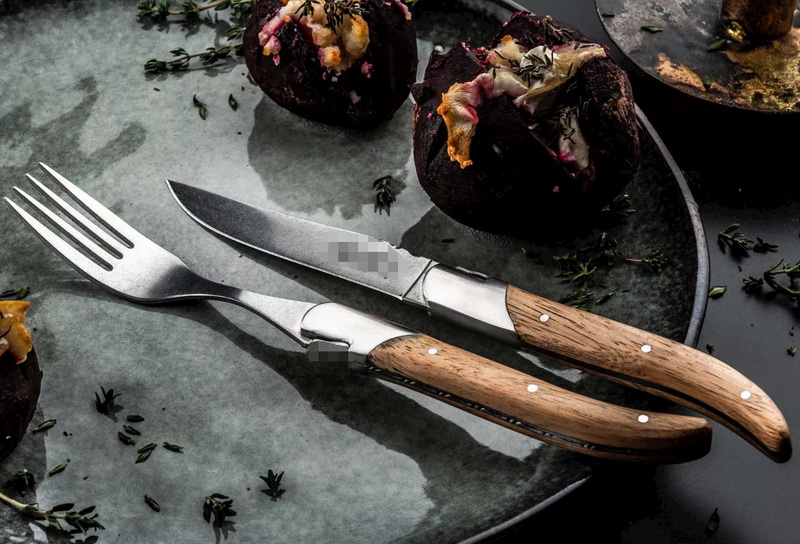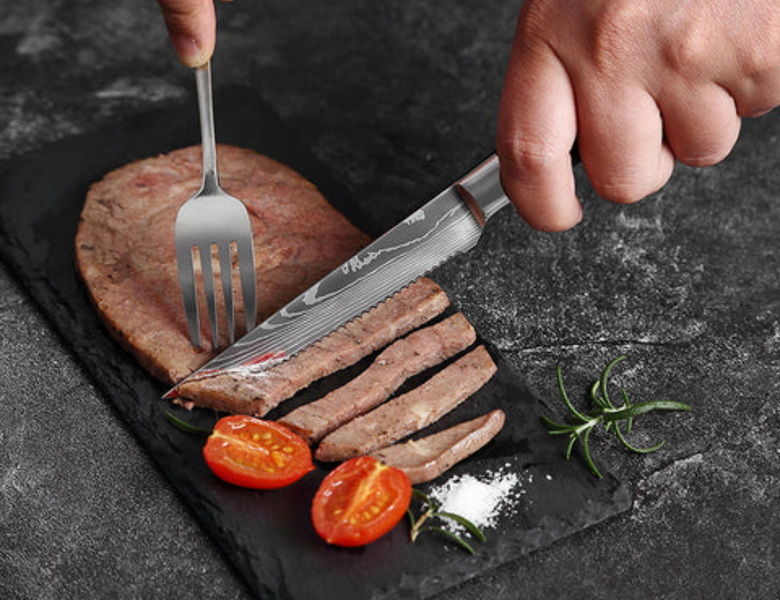- All
- Product Name
- Product Keyword
- Product Model
- Product Summary
- Product Description
- Multi Field Search
Views: 222 Author: Ann Publish Time: 2025-11-02 Origin: Site











Content Menu
● Why Steak Knife quality matters in luxury dining
● Core criteria for selecting a Steak Knife
● Blade material and edge type
● Handle design and ergonomics
● Construction quality and durability
● Types of Steak Knife for different dining contexts
● Materials-driven performance for premium dining
● Brand considerations for OEM partnerships
>> Quality control and supply chain reliability
● Care, maintenance, and presentation
>> Cleaning, sharpening, and storage
>> Presentation and service standards
● Market-ready considerations for OEMs targeting foreign brands
● Sustainability and ethics in Steak Knife production
● Careers and training implications for premium service teams
● Integrating Steak Knife into a luxury dining ecosystem
● Care, maintenance, and user education for end-users
● Practical OEM checklist for new Steak Knife programs
● FAQ
>> 1. What is the ideal Steak Knife blade length for formal dining?
>> 2. Should we choose serrated or straight-edged Steak Knives for premium beef cuts?
>> 3. What blade material offers the best balance of edge retention and corrosion resistance?
>> 4. How does tang design influence durability in a high-use setting?
>> 5. What customization options add the most value to an OEM Steak Knife program?
In the world of luxury dining, every detail matters—from the plateware to the lighting, from the wine list to the cutlery that graces the table. A Steak Knife may seem like a small component, but its role in shaping a guest's perception of quality is substantial. For brands and OEM partners in China supplying overseas markets, selecting the right Steak Knife involves a careful balance of material science, ergonomic design, manufacturing feasibility, and brand storytelling. This guide explores how to choose Steak Knives that elevate dining experiences, supports premium branding, and meets the practical demands of high-end hospitality and consumer markets.

In premium settings, guests judge the dining experience in many subtle ways. The act of slicing a steak should feel effortless, precise, and elegant. A well-made Steak Knife provides clean cuts that preserve the integrity of the meat's texture and flavor, avoiding tearing or shredding that can detract from the meal. From a brand perspective, a Steak Knife is a tangible ambassador of quality—its finish, balance, and edge retention reflect the overall standards of the culinary program and the supplier's reliability. A thoughtfully chosen Steak Knife also communicates attention to detail, which reinforces trust in an OEM partner's capability to deliver consistent, premium products across global markets. This section underscores why investing in superior Steak Knife design and manufacturing is not just a functional choice but a strategic branding decision.
A robust decision framework helps manufacturers and buyers evaluate options efficiently. The core criteria below cover material performance, geometry, ergonomics, and durability, all tailored to the expectations of luxury dining brands.
- Common materials: high-carbon stainless steels, stainless steel alloys with high corrosion resistance, Damascus variants for a premium aesthetic, and specialty alloys designed for edge retention.
- Edge types: straight-edged (non-serrated) for clean, precise cuts and serrated edges for durable performance against tougher textures; some premium models combine micro-serrations for a balance between initial bite and long-term sharpness.
- Material trade-offs: high-carbon stainless steels offer sharpness and ease of sharpening but may require more maintenance to prevent staining; Damascus patterns provide beauty and unique branding opportunities but may demand careful care to maintain microstructure; corrosion resistance is critical for hotel and restaurant environments where cleaning protocols vary.
- Practical guidance for OEM partners: align blade material with target market expectations, maintenance capabilities, and branding narratives (e.g., a Damascus-look for luxury boutique brands, or a performance-focused stainless steel for value-driven premium lines).
- Typical blade lengths for steak knives range from about 4.5 inches to 7 inches, with 5.5–6.5 inches being common in formal dining sets.
- Balance is the feel of the knife in the hand: a full tang and well-placed weight distribution reduce fatigue during extended service and improve cutting control.
- Ergonomic implications: a properly balanced Steak Knife enables smoother slicing actions, reducing wrist strain for servers and diners alike.
- OEM considerations: specify tolerances for blade length, tang configuration (full vs partial), and handle-to-blade balance to ensure consistent feel across batches and to support cohesive table presentation.
- Materials: stainless steel, composite resins (such as PEEK or G10), high-quality woods, and laminates that withstand commercial dishwashing cycles.
- Grip and contouring: rounded or subtly contoured handles with texture for secure grip; ergonomic finger grooves can enhance comfort during long service periods.
- Weight and perimeter feel: weightier handles can convey heft and luxury, but must be balanced against fatigue in high-volume environments.
- Brand implications: handle aesthetics—material, finish, and color—offer strong opportunities for branding through engravings, logos, or signature textures.
- Key indicators: full tang construction, triple-rivet handles, careful fit between blade and handle, and robust finishing (beveled edges, satin or mirror polish as appropriate).
- Durability considerations: resistance to corrosion, staining, and chipping; consistent edge retention under daily use; compatibility with typical restaurant cleaning regimens.
- Quality control: integration of torque tests, edge retention tests, and visual inspection protocols in OEM production lines to ensure uniformity across orders.
Non-serrated vs serrated steak knives
- Non-serrated knives offer cleaner cuts and preserve the texture of premium beef cuts; they require precise sharpening and higher-quality steel to maintain edge.
- Serrated knives excel in long service periods and can handle tougher seams or slightly tougher meat; they can stay sharp longer in some environments but may tear delicate fibers if not properly matched to meat type.
- For luxury restaurants, a mix of styles can be used to convey different dining concepts, but consistency in branding and performance is essential.
- Blade materials influence edge retention, corrosion resistance, and ease of sharpening; pairing material choices with target markets (e.g., hotel chains, fine-dining restaurants, or boutique brands) helps align price points and service expectations.
- Brand storytelling around material choices—such as a unique steel grade or craftsmanship narrative—adds value beyond functional performance.

- Blade shapes, engraving, and logo placement—these offer immediate branding impact on the product itself.
- Packaging and presentation: branded boxes, inserts, and display options that reinforce luxury positioning.
- Limited editions and commemorative runs: these can create excitement and exclusivity for high-end clients.
- Certifications (e.g., material traceability, food-grade safety standards), testing regimes, and clear lead times are critical for OEM buyers managing multiple markets.
- Supplier resilience: multi-sourcing for key materials, and robust QA processes reduce risk in global supply chains.
- Documentation: provide material certificates, wipe test results, and finish specifications to brand partners for compliance and marketing credibility.
- Cleaning: recommend hand washing or machine washing per material compatibility, with drying protocols to prevent water spots and corrosion.
- Sharpening: outline maintenance schedules; specify compatible sharpening tools and services, especially for high-end knives where subtle bevel angles matter.
- Storage: protective sleeves, knife blocks, or magnetic strips that protect both blade and finish; consider anti-corrosion storage solutions for humid environments.
- Table setting: coordinate Steak Knife designs with plateware, glassware, and cutlery care practices to present a coherent luxury dining table.
- Knife rests and accessories: provide branded rests or sheath options as part of the service experience, reinforcing premium branding.
- Regulatory compliance: ensure compliance with food-contact standards and regional regulations in key markets (e.g., EU, US, APAC) to avoid delays or recalls.
- Lead times and batch consistency: establish predictable production calendars and QA checkpoints to meet partner expectations across different seasons.
- After-sales support: offer replacement programs and warranty coverage that align with partner marketing claims and consumer expectations.
- Raw materials sourcing: emphasize responsibly sourced steels and woods, and explore recycled-content options for handles and packaging.
- Manufacturing footprint: communicate energy efficiency measures, waste reduction, and non-toxic finishing processes to brand partners concerned with ESG criteria.
- End-of-life considerations: design for disassembly where possible to facilitate recycling or safe disposal at end of product life.
- Staff training: equip front-of-house teams with knowledge about Steak Knife materials, care, and handling to enhance guest experience.
- Demonstration and storytelling: use the Knife's material and build story as a training hook for sommeliers, chefs, and service staff when presenting the dining program to guests.
- The Knife as brand ambassador: a premium Steak Knife can carry the host brand's narrative across menus, uniforms, and guest communications, reinforcing consistency.
- Synergy with other cutlery and tableware: coordinate finishes, weights, and ergonomics with forks, spoons, and bowls for a cohesive table aesthetic.
- Lifecycle management: plan for upgrades, refill programs, and limited-edition runs that maintain guest interest and brand momentum.
- User guides: provide clear, concise maintenance instructions aligned with the material and finish of the Steak Knife.
- Safety reminders: emphasize safe handling and storage to prevent accidents or injuries, especially in high-volume residential or hospitality settings.
- Brand storytelling for consumers: communicate how material choices and craftsmanship contribute to a superior cutting experience and long-term value.
- Define target market and price tier
- Select blade material and edge type
- Determine blade length and handle geometry
- Decide on iconography, engraving options, and packaging
- Establish QA protocols and lead times
- Plan marketing assets and storytelling elements
- Prepare after-sales support and warranty terms
- Align with cleaning and care guidance for end-users
- Validate regulatory compliance and certifications
This structured checklist helps ensure that the final product aligns with luxury dining expectations while remaining scalable for international OEM partnerships.
Choosing Steak Knives for luxury dining experiences is a blend of science, artistry, and strategic branding. The right combination of blade material, edge geometry, ergonomic handle design, and durable construction delivers not only superior cutting performance but also a compelling story for international brand partners seeking premium cutlery programs. For OEM manufacturers, the opportunity lies in translating material science and craftsmanship into a consistent, scalable product that supports a brand's luxury narrative across markets. When aligned with thoughtful packaging, careful care guidance, and robust after-sales support, a Steak Knife program becomes a powerful element of a luxury dining ecosystem, empowering restaurants and retailers to deliver exceptional guest experiences every service.

A typical formal dining setup favors blade lengths around 5.5 to 6.5 inches for balanced control and elegant presentation. This range supports precise cutting while maintaining table aesthetics.
For premium beef cuts where texture preservation is important, straight-edged Steak Knives are preferred for clean cuts, with serrated options reserved for durability in high-use settings or multi-course services.
High-carbon stainless steels are commonly preferred for this balance; however, Damascus-like patterns can offer branding advantages with appropriate care programs.
A full tang with robust rivets enhances durability and balance, reducing the chance of handle separation during heavy use. This is a key criterion for professional hospitality environments.
Engraving, branded packaging, and coordinated finishes across knife and storage solutions tend to deliver strong branding impact and customer recognition.
The Ultimate Professional Knives for Halal Butchery in Middle Eastern Kitchens
Chef Knife Size Guide: Choosing Between 6″, 8″, 10″, And 12″
Custom Knife Handles: How To Design A Chef Knife That Fits Your Hand Perfectly
Chef Knife Surface Treatments Guide: From Polished Migaki To Damascus Patterns
Inside Our Professional Knife Sample Room: Quality You Can See
Universal Knife Block Buying Guide: Modern Acrylic & ABS Knife Holders for Professional Kitchens
Universal Knife Block: The Complete Guide To Modern, Hygienic Knife Storage
The Complete Guide To Red Handle Knife Sets: Style Meets Functionality in The Kitchen
Professional Knives for Halal Butchery And Middle Eastern Cuisine